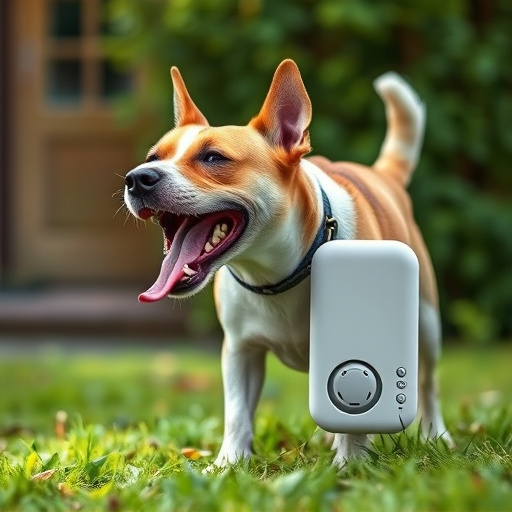Advanced dog repeller technology offers effective outdoor solutions for behavior management, utilizing ultrasonic or pulsating sounds beyond human hearing to deter dogs. Success hinges on durability and frequency range, with weather-resistant, long-lasting devices recommended. Key features include robust materials, high-frequency sounds disrupting canine communication, suitable coverage for yard size, water resistance, easy setup, and adjustable sensitivity levels. Testing through controlled trials ensures pet owners invest in reliable, durable outdoor-rated dog repellents for managing dog intrusion.
“Deterring dogs from entering your yard or garden can be a challenging task, but with outdoor-rated dog repellents, you gain an effective solution. These devices utilize specific frequencies to keep dogs at bay without harm. Understanding the technology behind them is key to choosing the right fit.
This article explores essential aspects of dog repeller technology, factors to consider for durable outdoor use, and how to evaluate their frequency range. By delving into these topics, we aim to guide you in selecting a reliable outdoor-rated dog repellent that ensures both effectiveness and longevity.”
- Understanding Dog Repeller Technology: How Does It Work?
- Factors to Consider When Choosing an Outdoor-Rated Dog Repellent
- Durability and Weather Resistance in Dog Repellents
- Testing and Evaluating the Effective Frequency Range of Dog Repellers
Understanding Dog Repeller Technology: How Does It Work?
Dog repellers have evolved from simple visual or scent deterrents to advanced technological solutions. At their core, these devices utilise specific frequencies to create an unpleasant sensation in dogs, encouraging them to avoid certain areas. This technology is particularly useful for outdoor spaces where traditional methods might not be feasible or effective.
The key to a successful dog repeller lies in its durability and the range of frequencies it can emit. Outdoor-rated dog repellents are designed to withstand varying weather conditions, ensuring they remain functional over an extended period. These devices often utilise ultrasonic or pulsating sounds in the high-frequency range, well beyond human hearing, which disrupts a dog’s sense of balance and orientation, leading them to leave the area. Understanding this technology ensures pet owners can choose a reliable solution for managing their dogs’ behaviour effectively.
Factors to Consider When Choosing an Outdoor-Rated Dog Repellent
When selecting an outdoor-rated dog repellent, durability should be your top priority. You’ll need a device that can withstand harsh weather conditions, from heavy rain to scorching sun, without compromising its functionality. Look for robust materials and a sturdy design that can resist wear and tear, ensuring it lasts through multiple seasons of use.
Other factors to consider include frequency range and consistency of the signal. An effective outdoor dog repellent should emit a consistent high-frequency sound or vibration that disrupts dogs’ communication and discourages them from approaching. Ensure the device operates on a range suitable for your yard size and terrain, providing thorough coverage without any dead zones. Additionally, check for features like water resistance, easy setup, and adjustable sensitivity levels to tailor the repellent to your specific needs.
Durability and Weather Resistance in Dog Repellents
When choosing a dog repeller, durability and weather resistance are key factors to consider, especially if it’s meant for outdoor use. Look for products labeled as ‘Outdoor Rated’ or ‘Weather Resistant’ to ensure they can withstand the elements. These repellents are designed to be sturdier, with stronger materials that can resist fading, cracking, or rusting due to sun exposure, rain, and wind.
The durability of an outdoor dog repeller is crucial for maintaining its effectiveness over time. High-quality materials ensure the device can endure regular use and harsh weather conditions, allowing you to protect your yard or garden consistently without frequent replacements.
Testing and Evaluating the Effective Frequency Range of Dog Repellers
Testing and evaluating the effective frequency range of dog repellers is crucial for ensuring their durability and performance in various outdoor settings. These devices often claim to use specific ultrasonic frequencies to deter dogs, but not all products live up to their claims. To assess a dog repellent’s effectiveness, researchers conduct controlled tests where different models are exposed to multiple dog breeds under varying environmental conditions. The frequency response is measured using specialized equipment, simulating the hearing range of canines and humans for accurate comparison.
Outdoor-rated dog repellents must withstand harsh weather conditions to maintain their functionality. Durability testing involves subjecting the devices to extreme temperatures, moisture, and physical stress to simulate real-world use. Repellents that perform consistently across different frequency ranges and retain their structural integrity are considered superior in terms of both effectiveness and longevity. This rigorous evaluation ensures that pet owners invest in a reliable solution for managing dog intrusion in outdoor spaces.
When selecting an outdoor-rated dog repellent, durability and weather resistance are key factors. Understanding the effective frequency range ensures the device works as intended. By considering these aspects, you can choose a reliable product that keeps dogs at bay while withstanding outdoor conditions, providing a peaceful and controlled environment for all.
